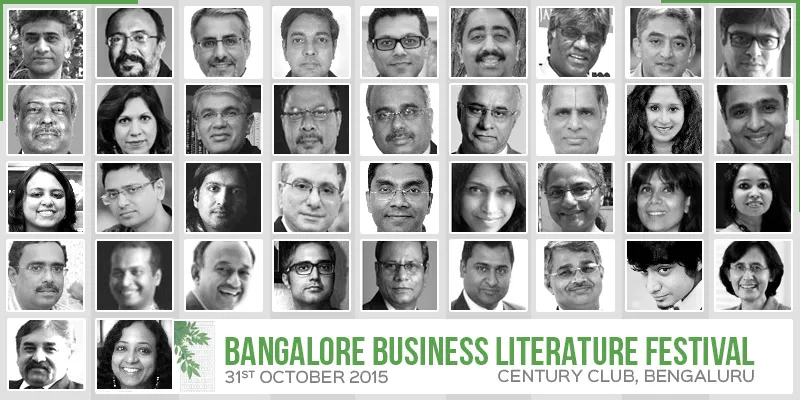The entrepreneur boom: Bangalore Business Literature Festival addresses creative models and digital content
The economic rise and creative boom in India is leading to a wave of macro and micro-level shifts in society and business. “What’s happening in Indian business today is not once in a decade or once in a millennium but once in the lifetime of a country,” says Manish Sabharwal, Co-Founder and Chairman of TeamLease Services and Venture Partner at The View Group.
A powerful factor that drives the knowledge economy is how often and how deep are the conversations that take place between various stakeholders in the ecosystem, says Benedict Paramanand, author and organiser of the inaugural Bangalore Business Literature Festival (BBLF), kicking off on October 31. (See also my earlier articles on the startup boom in India and the power of entrepreneurship stories.)

“The festival is an effort to become a platform for rich conversations between various stakeholders of business literature,” he says. Over 40 speakers and around 400 delegates are expected at the event, covering topics from entrepreneurship and e-publishing to business culture and economic reforms.
Business literature for education
“There hasn’t been a better time for business writers to get their work published than today,” says Rakesh Godhwani, author of the books Plunge, Finding Your True Calling, and What to Say and When to Shut Up.
“As a teacher and a researcher myself, I can see that the books and cases that I read as a student are not enough to solve the problems that my students are facing today. There is a screaming need for new perspectives, credible data, relevant stories (in books or cases), current facts and figures about businesses,” he adds.
Writers have many more choices to publish other than just books, thanks to the explosion of smart devices which have democratised the digital publishing world. “A writer can now blog, tweet, or even post a video or an infographic to communicate with his audiences, which can be quite exciting. The opportunities for publishers are equally promising as well,” he explains.
Executives are also warming up to the concept of a refresher programme via executive education every five to seven years. “Case in point: the executive programmes at IIM Bangalore are huge blockbusters. This is a big market for business writers and publishers,” observes Tony Francis, a radio professional with over 15 years of experience in the FM radio industry and Secretary of the IIMB Alumni Association, Bangalore Chapter.
This period of transition is ripe for research into success factors of traditional and emerging businesses. “The old order has not died yet but is decaying and the new one has not yet been accepted but has been born. Transitions are always a wonderful time for stories of challenge, courage, change and much else,” says Manish.
Ripe areas to write about are how India could skip the learning of developed markets in many areas, he suggests. “Indian business must also live up to the higher standards that society holds it to, and pitch in various ways to help eradicate poverty,” Manish adds.
“As private sector business in India gains in profile and importance, the subject of business management and education will increase in significance,” says R. Gopalakrishnan, who has had an illustrious career as a corporate leader for 31 years in Unilever and 17 years in Tata. His books include The Case of the Bonsai Manager, When the Penny Drops, What the CEO Really Wants from You, and A Comma in a Sentence.
The space for continuing education, business books and experience sharing will strengthen among established professionals as well as emerging startups. This outlines the key opportunity for business writers and publishers, observes Gopalakrishnan.
Economic growth
There is growing interest in the world of business among the general audience in India. “Because of economic liberalisation, there is more openness in the business world. More people from the middle-class are opting for entrepreneurship. Things like the stock market and mutual funds which were the preserve of the handful are now accessible to a much larger audience,” explains Sudheesh Venkatesh, Chief People Officer at the Azim Premji Foundation.
Today, there are more success stories in Indian business one can write about. “On one hand, you have companies like Infosys and Flipkart set up by first-generation entrepreneurs, and then there are India-origin persons like Sundar Pichai and Satya Nadella heading iconic global companies. So there is much more fodder for business writers and publishers,” adds Sudheesh.
New categories of businesses are being created and new brands are being born thanks to the rise of digital media. “There is the burgeoning field of e-commerce, for example, and the rise of technology brands like Apple and Google internationally, and Micromax and Tally in India. Writers and publishers are going to have their hands full helping readers make sense of these new technologies and new businesses,” he says.
Financial and business literacy is growing faster, broader and deeper. “Ordinary folk, including those not working in the formal sector, have bank accounts thanks to Aadhaar, invest in mutual funds and stocks, get it that Prime Minister Narendra Modi’s biggest task is to revitalise the Indian economy and make it globally competitive, and generally have a larger appetite than ever before for understanding how the economy works, how businesses make their money or flounder,” observes Shankar Parameshwaran, an editor with Knowledge@Wharton and formerly resident editor of The Economic Times in Mumbai and Bengaluru.
These are the best of times for business publishers in terms of market opportunity, but also challenging in terms of figuring out digital models. “For publishers, digital publishing has upended their old business models and disrupted cost structures while also expanding the community of authors, writers, bloggers and other producers of business content that are prolific, cogent and well informed,” says Shankar.
“Citizen journalism, the growth of broadcast media and the play of business news on the front pages of general newspapers have all contributed to making the average Joe or Joginder a ready, salivating market for publishers,” he adds.
Room for scale
While all this is encouraging news, there is still room for growth. “The business genre is very small, crowded, and probably not very profitable for a new author. There is a ‘halo effect’ in audiences, including me, who tend to buy a book of an author who is ‘famous’ or a book which is on some Top 10 or 100 list of some sort,” says Rakesh.
In any library in the headquarters of the established corporate houses, there will be business books written by famous and established western authors sitting in the shelves to make the office look more ‘global,’ he adds.
Another challenge he identifies is that companies in India do not readily share data which can be used by an author to write a case study, which can then be taught in a B-school or published to a wider audience around the world in the form of a book.
“MBA programmes still refer to foreign examples. Philip Kotler’s marketing books are great but I am also very glad to see Prof. Y.L.R Murthy from IIM Bangalore releasing the book Marketing that works in India,” says Tony. The book picks up hundreds of illustrations from the Indian market and builds theory based on those illustrations – such books should also be given place starting with the business schools, he advises.
“One of the most obvious challenges in business publications also confronts Indian literature: the lack of great biography,” says Manish. “Role models are key to imagination and courage and hopefully we will see the lives of many first-generation entrepreneurs being chronicled,” he adds.
“Management is more akin to performing arts like dance and sports than to scientific disciplines like physics and engineering. That is why learning in management occurs through experience-sharing by more experienced people. Managers with experience are often not writers and conversely, writers may not have the experience. This is a challenge to be overcome,” adds Gopalakrishnan.
Another challenge he identifies is with respect to language. “I often say that Indian managers think in English but act in Indian,” he observes, a point that opens the door to yet another world of business literature in Indian languages.
The credibility challenge
Digital publications have the advantage of almost unlimited space, interactivity, and search features. “For writers, formats like blogs offer great scope for individuated business writing. Facts and figures can be better represented through attractive infographics. But with the line between PR and news getting blurred by the day, the credibility problem has become more acute,” cautions Sudheesh.
“Business journalism, like any other kind of journalism, acquires value and relevance only on account of its credibility. So it is something everyone in the field has to work together to protect,” he advises.
“For writers and other creators of business content, telling stories that are relevant, compelling, well-informed, credible and must-reads are among the major challenges. Every publisher wants a dozen more Amish Tripathis or Chetan Bhagats,” jokes Shankar.
Digital publishing is a double-edged sword that reduces costs and expands market access but also reduces unit revenue and makes promotion and marketing more complex. “More resources than ever before need to be spent on research, fact-checking and thoroughness, while taking care of fairness and balance – all the while reducing time to market,” he explains.
“Digital publishing has also meant writers now have to render their content suitable for online publishing or mobile devices and write more concisely to be in step with shorter attention spans among readers,” Shankar concludes.
For more nuances on the business models of publishing and how entrepreneurs can get into this space, check out the Bangalore Business Literature Festival or follow it on Twitter (@BlrBizLitFest, #BBLF2015).







